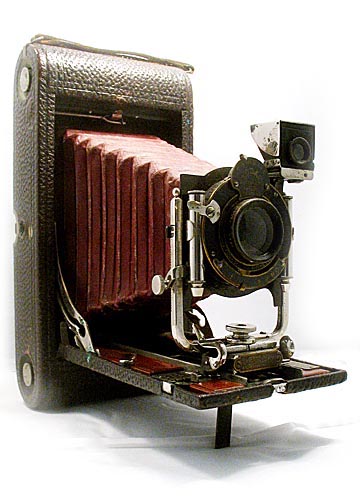
Kodak 3A Pocket Folding Camera
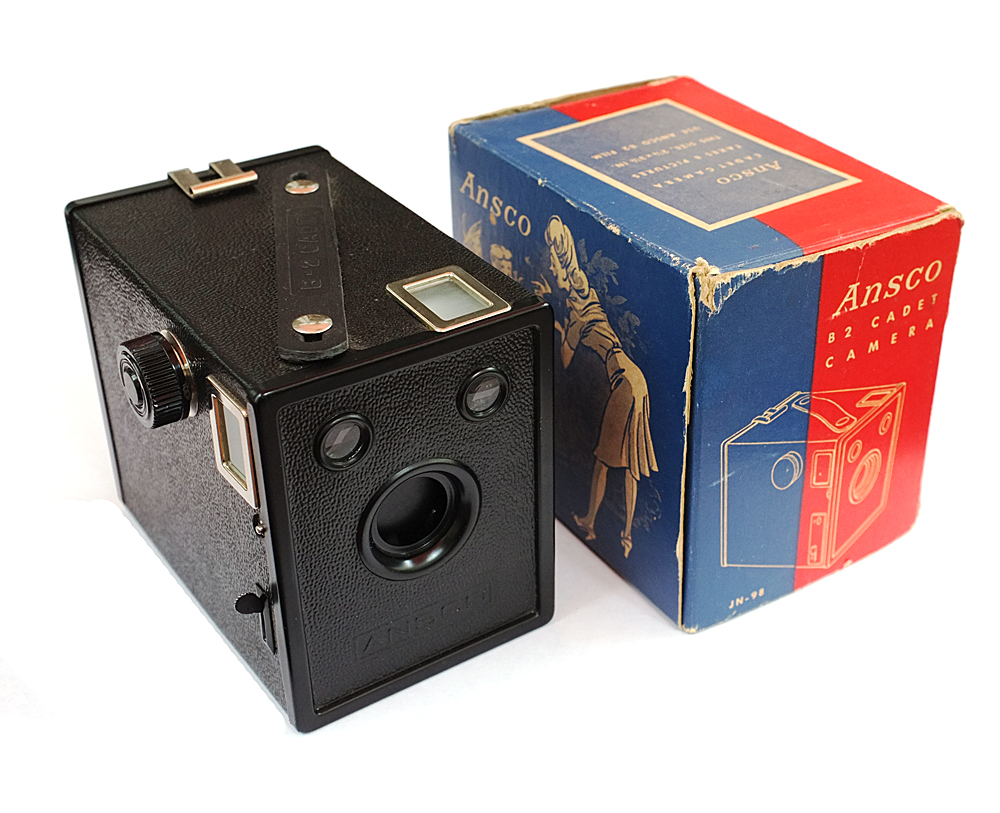
The Ansco B2 Cadet was produced from about 1937 to 1939. It is a cheaper version of the German designed Agfa B2, the main difference being the lack of a time exposure mode. The camera is quite nice looking, but made of cardboard. The two brilliant viewfinders used polished steel for the reflex mirrors, which gave a dim image. I found this nearly mint example, with its original box, on EBay. I applied self-stick non-glass mirror cut to size over the polished steel mirrors, and got a much brighter and clearer image in the viewfinders. The camera uses 120 film and takes eight 6X9cm images.
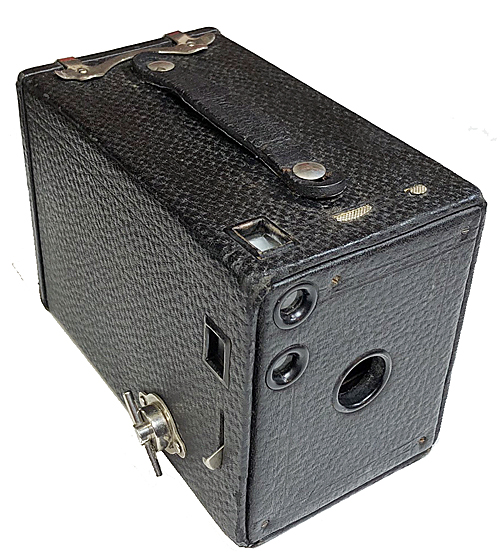
The first camera to use 120 roll film, the Kodak No. 2 took 2-1/4" x 3-1/4" images. The first Model 2 was introducted in 1901. Various changes and improvements were made during the life of the Kodak Model 2, which was discontinued in 1935. The Model D, shown here, was introduced in 1914. All models through the Model E were made of cardboard. The final model, the Model F, introduced in 1924, had a metal body, tripod sockets, and other improvements, and is the most desired model.
I found this copy on EBay, and it was described as a Model F. When I received it, I discovered it was a Model D. However, I only paid $12 for it, and it was in extremely good condition, so I decided to keep it. The Kodak No. 2 has a shutter speed of about 1/50 second. The shutter opens when the release is tripped in either direction, up or down. The Model D feathures a T setting and has three f/stop settings, f/11, f/22, and f/32.
I first removed the front plate, which is held in place by four tiny screws, visible in the photo. This gives access to the shutter mechanism and the reflex mirrors. I cleaned out the dust, and applied a bit of lighter fluid to the shutter mechanism to remove accumulated grime. Both mirrors had come unglued, and were loose. I cleaned them, but as usual, they were beyond salvation. I applied vinyl stick-on mirrors to both and reglued them. The frosted viewfinders and clear view ports were cleaned. The view finders are now clean, clear, and sharp.
I used Kiwi black shoe dye to cover some worn spots on the leatherette covering. The strap is very fragile, and would likely break if used. I removed it and stabilized the strap by apply bookbinding tape to the bottom , but it is not safe to carry the camera by the strap. All the hardware is in very nice condition, still bright and free of corrosion. All in all, a nice example of the Kodak No. 2, and in working order.
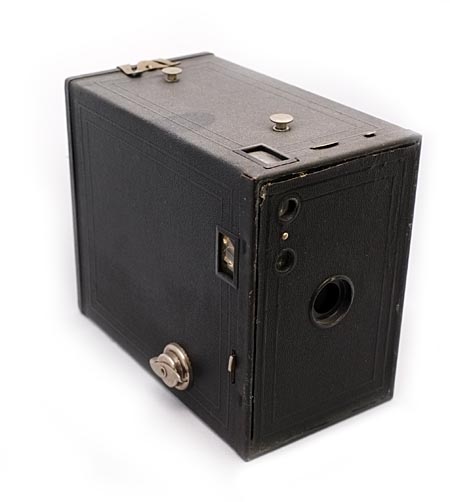
Similar to the Kodak Bownie 2, the Kodak Brownie 2A was in production from 1907 to 1936. Rather than 120 film, the 2A used 116 film, and over two million were sold. Otherwise, the Model 2A shares the same features of the Model 2. The handle is missing on this example. I found the 2A in a thrift store.
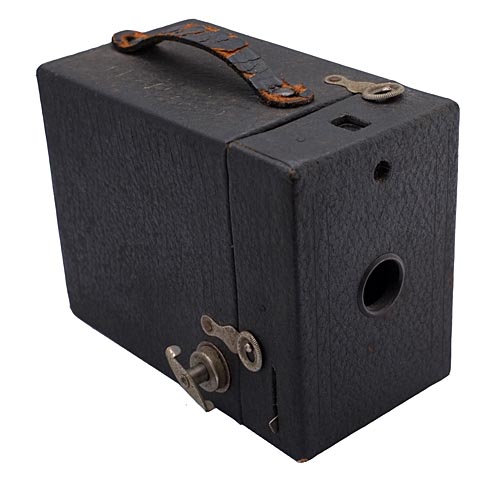
The Cartridge Hawk-Eye Model C was in production from 1926 to 1934. The Model C used 120 film, and had a fixed lens. Hawk-Eye cameras were first made by the Boston Camera Company. Eastman Kodak acquired the brand in 1899. This example came from a consignment store. Like most box cameras of the era, this Hawk-Eye is made of cardboard. I removed the front cover and cleaned the lens, and replaced the peeling reflex mirror with a self-stick non-glass mirror cut to size. The camera only offers a portrait mode viewfinder, which is quite small, and composing an image is quite challenging. The camera actually takes pretty good images, though. An example can be seen in the Gallery of Images from Vintage Cameras.

Unlike the box cameras shown above, the Kodak Brownie Target Six-16 had a metal body and a very nice Art Deco front. The camera featured two f/stops: f/11 and f/16, and a time exposure mode. Two brilliant finders allowed portrait or landscape images. The camera was produced from 1946 to 1951. I found this one in an antique shop in Lexington, KY, in like new condition.
Although 616 film is no longer available, adapters are available from online sellers to allow the use of 120 film in this camera. I bought a set and ran a roll of 120 film through the camera. With adapters, the camera will take six 6x11cm panoramic images per roll. An image from the roll can be seen in the Gallery of Images from Vintage Cameras.
Kodak produced the 3A series of cameras to use their newly developed 122 roll film. 122 film produced a negative that was the size of a postcard, measuring 3-1/4 x 5-1/2 inches. A postcard size image could be printed directly from the negative using a contact printer. The cameras are well-built, with wood and metal housings, lots of brass and nickle-plated brightwork, and a faux leather covering which has worn well in most cases over the past century. Kodal discontinued 122 roll film in 1971, but 120 roll film can be used in these cameras with a set of spool adapters. A roll of 120 film will produce four panoramic exposures, about 60mm by 114mm, or 2-1/4" x 5-1/2."

Kodak 3A Pocket Folding Camera
The name is a misnomer. The camera is huge and will not fit in a large coat pocket, much less a shirt pocket. First produced in 1903, the 3A was Kodak's first camera to use film that produced postcard sized images. Kodak designed 122 roll film specifically for this camera.
Compared to most consumer cameras of the era, the Kodak 3A was a much more complex camera. It was manually focused, and it had an adjustable lens with approximate stops from f/8 to f/45. Shutter speed could be adjusted from 1/25 second to 1 second, with an Instantaneous setting of 1/100 second for handheld snapshots, plus T and B settings.
The camera was first sold in 1903. A number of improvements were made over the years, and the camera continued in production until 1943. Mine is a Kodak 3A model B, and appears to be in working condition.

Kodak 3A Folding Brownie
The Model A Kodak 3A Brownie, shown here, is a much more sophisticated camera. Distinguisehd by the black bellows, the camera featured a Rapid Rectilinear Baush & Lomb f/8 lens, probably around 100mm or so, Brownie ball bearing shutter, and adjustable settings. Shutter speeds available are 1/25s, 1/50s, and 1/100s. The lens diaphragm, which is marked in the old U.S. System, are 4, 8, 16, 32, and 64. The modern equivalents are f/8, f/11, f/16, f/22, and f/32.
I purchased this camera on EBay, and it is in almost mint condition, except for the missing strap on top. The reflex viewfinders on the cameras are typically useless because the mirrors have degraded beyond salvation. On both these cameras, I repaired the mirrors using self-adhesvie non-glass mirror stickers cut to size and just applied over the original mirror. Getting access to the mirrors, though, is tricky and may require some repair work to the reflex housing.
I further customized the Kodak 3A Brownie for field use by adding a very nice Albaba viewfinder from a Kodak Monitor folding camera. The Kodak Monitor viewfinder has a bright view, formatted for 6x9, and has adjustable parallax correction. The top mounted folding viewfinder is much easier and more convenient to use than the reflex finder mounted on the lens bed. I installed an accessory shoe from an Argus C3 parts camera so I could mount a rangefinder or a light meter.
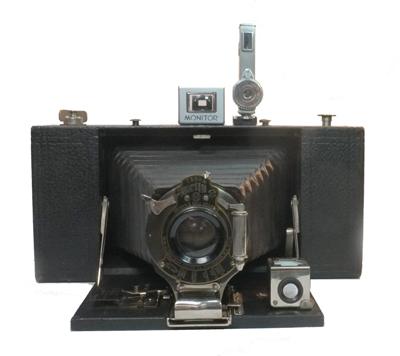 The lens is clear, but had some internal dirt and dust, so I removed the optical block from the bellows and cleaned the insides of both the front and rear elements. Again, removing the optical block is tricky, as the bellows has to be fully extended and I had to work carefully to avoid damaging the bellows. I had to make a spanner wrench to fit the slots in the retainer, and attach it to a handle long enough to reach inside the bellows and unscrew the retainer, after which the lens and shutter assembly can be removed from the front. To re-install, I had to improvise a tool to hold the retainer in place from inside the bellows while threading the optical block into the retaining ring from the outside. Once the threads bit, I was able to hold the lens in place and tighten the retainer from inside the belows with my special spanner wrench.
The lens is clear, but had some internal dirt and dust, so I removed the optical block from the bellows and cleaned the insides of both the front and rear elements. Again, removing the optical block is tricky, as the bellows has to be fully extended and I had to work carefully to avoid damaging the bellows. I had to make a spanner wrench to fit the slots in the retainer, and attach it to a handle long enough to reach inside the bellows and unscrew the retainer, after which the lens and shutter assembly can be removed from the front. To re-install, I had to improvise a tool to hold the retainer in place from inside the bellows while threading the optical block into the retaining ring from the outside. Once the threads bit, I was able to hold the lens in place and tighten the retainer from inside the belows with my special spanner wrench.
I used 1/16" strips of female Velcro around the rear film compartment door as I was concerned about light leaks. And I plugged the red window as it isn't needed with 120 film. I lubricated the rollers, film spool axles, and winding knob. The shutter and lens iris all seem to be in good working condition. The shutter can be tripped by hand or an air bulb release. I made an air release using a rubber squeeze bulb and tubing to fit the Kodak's air inlet. I used a set of 122 to 120 adapters to shoot a roll of 120 film through the camera. All four panoramic images came out quite good. There were no light leaks from the bellows or rear door. This is a really fun camera for old school landscape photography.
My great-grandfather used a Kodak 3A. In 1920, he took his family on a cross-country tour in a Model T Ford from the Yakima valley in Washington state to Niagara Falls, NY, by way of California, Mexico, and across the mid-West. His images are published in a book, Across America in Our Model T, available at Amazon.com.
Although I am not sure which Kodak 3A he used, all his images are in landscape format, and my guess is that his camera was the folding Brownie version, and it would have been a more affordable and simpler to use camera for the trip.
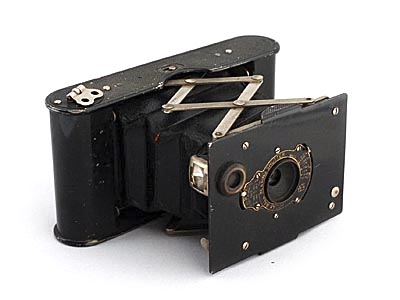
One of Kodak's best selling cameras, the Kodak Vest Pocket models were produced in several grades from 1912 to 1935. This was the first camera to use 127 roll film. This model, which I found at an estate sale, is an Autographic model, so called because there is a door on the back of the camera that can be opened, allowing the photographer to write notes on the negative using a special stylus. Many of these cameras were carried by soldiers during WWI.
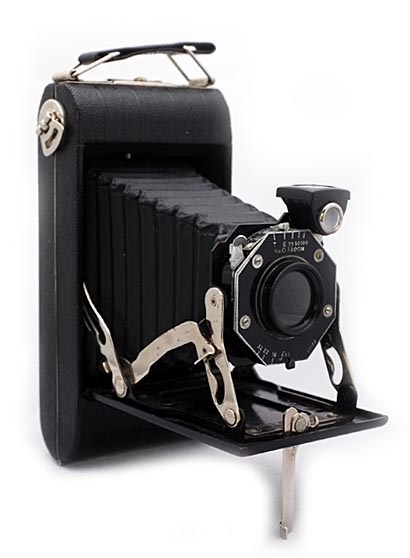
The Kodak Junior Six-20 camera was marketed from 1932 to 1935 to customers who wanted more than a simple Brownie box camera. It featured very attractive Art Deco styling, but this base model, shown here, wasn't much of a performer. One of the first cameras to use 620 film, the camera featured a f/11 lens and shutter speeds up to 1/100s, and a No. 0 Kodon shutter. Fancier models had faster lenses and Compur shutters. The base model cost $10.00 in 1933, the equivalent of $480 today. This camera was given to me.
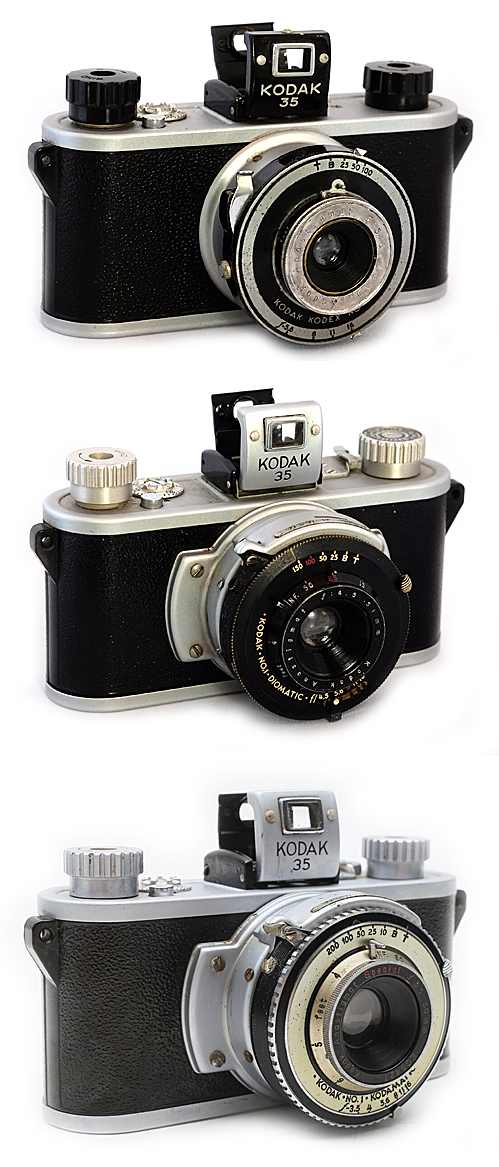
Although Kodak invented the 35mm film cassette in 1934, it did not produce a domestic built Kodak camera to use it, instead importing the German built Kodak Retina cameras. But with potential war threatening to disrupt importation of Retinas from Germany, in 1938 Kodak developed the Kodak 35. While lacking the refinement of the Retina cameras, the Kodak 35 was nevertheless a solid, well-built camera with very good Kodak lenses.
The first model, equipped with a rather slow 50mm f/5.6 Anastigmat lens, is easily identified by the black knobs and view finder on the top deck. F/stops of f/5.6, f/8, f/11, and f/16 and T and B were provided. The Kodex No.1 shutter is cocked when film is wound, so all the Kodak 35 versions, including the rangefinder model described later, can only be cocked when there is film in the camera. The button next to the film advance knob is not the shutter, but a double exposure prevention feature. The button has to be depressed before the film can be advanced to the next frame.
I purchased all three of these cameras on EBay. The first version shown here is not working as the shutter sticks, which could be fixed with a good cleaning, no doubt. The Kodak 35 is a small camera, 5 inches wide, 2-3/4 inches high, and 2-1/2 inches deep. Strap lugs are provided. Production was discontinued in 1942,although this model is sometimes mistakenly called a WWII blackout model. Some Kodak 35 cameras were produced for the military, but they were painted green.
A faster version was available with a silver colored 51mm f/3.5 lens, and this camera was supposedly produced from 1938 to 1949. The version shown here, though, has a 51mm f/4.5 lens painted black, and has a Kodak No.1 Diomatic shutter. There is no lens serial number, so it is a pre-WWII model. F/stops range from f/4.5 to f/16, and the Diomatic shutter offered speeds up to 1/150 second. The camera also features an accessory shoe and a self-timer. This model appears to be uncommon. It is in working condition
The third example shown here is a less common version with a brass colored lens bezel, rather than silver. The lens is a Kodak Anastigmat Special 50mm f/3.5, with a Kodak No.1 Kodamatic shutter. The lens serial number is ECXXXX, which is a 1941 production date. Top shutter speed is 1/200, with f/stops from 3.5 to 16. This is also a working example from EBay.

In spite of its looks and Rube Goldberg rangefinder, the Kodak 35 rangefinder model actually performs well. The rangefinder is easy to focus and accurate, although the RF view port is rather small and almost impossible to use with eyeglasses. The Kodak Anastar f/3.5 50mm lens is sharp, with f/stops from f/3.5 to f/16. Shutter speeds of 1/10, 1/25, 1/50, 1/100, and 1/200 are set when the film is advanced. The shutter release is mounted on the lens; the button next to the film advance is a double exposure prevention feature.
Kodak cobbled an external rangefinder to its 1938 Kodak 35 camera to compete with the Argus C3. Produced from 1940 to 1951, the Kodak cost twice as much as the Argus C3; consequently it did not sell well, even though some consider it to be a technically better camera than the Argus C3. I found this one at Goodwill, and it is in good working and cosmetic condition. I found the camera actually much easier to use than the Argus C3, and it takes good photographs.
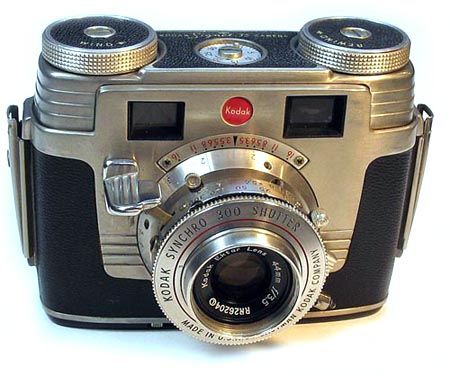
The Kodak Signet replaced the clunky Kodak 35 and Kodak 35 Rangefinder cameras in the early 1950's and was Kodak's best selling 35mm camera into the early 1960's. The camera is actually quite small, but very well built, although lacking the finesse of the German built Kodak Retinas. It has a similar manual cocking shutter lever that had to be set for each exposure. Like the Retinas, the Signet has a counter-clockwise turning film advance knob, but the shutter release is the large lever at the 9 o'clock position on the lens
The camera may have been originally developed for military use, and black and OD colored military versions are sometimes seen. The oversized controls allowed the camera to be used with gloves. Shutter speeds were limited to B, 1/25, 1/50, 1/100, and 1/300 seconds. The sharp Kodak Ektar 44mm lens has f/stops ranging from f/3.5 to f/22. The camera has a manually set film counter, but no accessory shoe.
I found this example on EBay. The camera and lens are in very good cosmetic and mechanical condtion. The camera takes excellent photographs, and is fun to use.

A gift from my sister, this Kodak Pony camera featured a Kodak Anaston 51mm f/4.5 lens, stoppable down to f/22. Shutter speeds were B and 1/25 to 1/200 seconds. The Model B version was produced from 1953 to 1955. It was position as an upgrade from the Kodak Brownie cameras. The shutter is very slow in this example, which might be fixed with disassembly and cleaning.

Produced from 1959 to 1969, the Kodak Automatic and Motormatic were Kodak's first autoexposure cameras. Clunky and very basic, the cameras have limited functionality compared to most other 35mm cameras of the day. Even the Kodak Signet was probably a better camera.
The cameras worked by setting the ISO (ASA) and the mode to automatic. The Kodak Automatic only offered two shutter speeds, 1/40 and 1/80 and a maximum ISO setting of 160. The Motormatic did offer four shutter speeds of 1/40, 1/80, 1/125, and 1/250, and ISO up to 800. Both are fitted with a pretty decent 44mm f/2.8 Ektanar lens.
The Automatic had a bottom mount film advance lever. The Motormatic had a large round winding knob on the bottom of the camera that wound a clockwork spring motor that could advance the film for seven to ten frames. When the motor ran down, it could be wound again for another seven to ten frames.
I purchased these two cameras together from an EBay seller. Both were in excellent cosmetic condition, looking almost unused, although sold as untested, for parts or repair. As it turned out, the Kodak Automatic appears to work fine. The Motormatic did not.
The winding mechanism was jammed. I removed the bottom plate, which contains the spring motor drive, governor, and the clutch. I was able to release the tension on the spring, but couldn't get the motor to engage the film take up spool. I found a cheap, working beater on EBay and installed the bottom plate on the nice Motormatic, and now have a working, nearly mint Motormatic camera. Although the light meters respond to light, I'm sure they are no longer accurate.
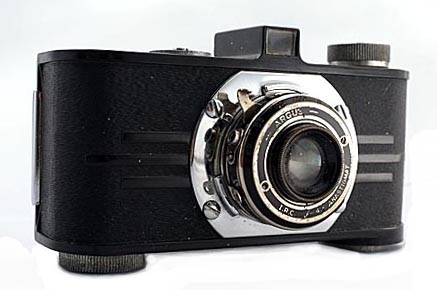
The camera that started the 35mm revolution in the United States. Prior to the Argus A, a 35mm camera was an expensive import. Introduced in 1936 by the International Radio Corporation, the Argus A was priced at $12.50, and thousands were sold, making IRC a player in the 35mm camera field. Camera sales were so successful that IRC sold off their radio business and concentrated on camera manufacturing. I found this example in an antique shop in St. George, Utah.
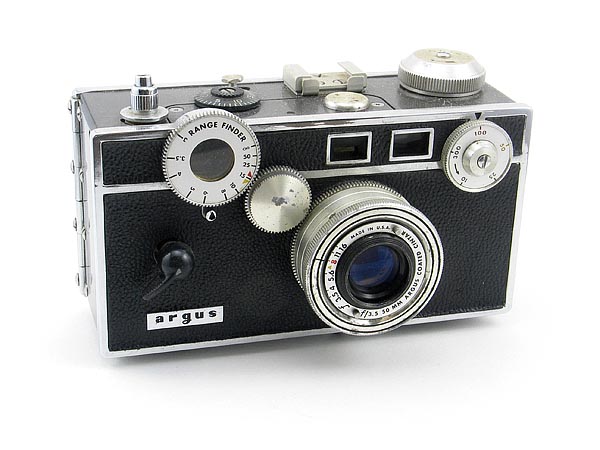
Known affectionately as "The Brick," the Argus C3 was in production from 1939 through the mid-1960's, replacing the successful A series cameras. It was one of the most successful cameras of all time as over two million were sold during its lifetime. My dad had one of these in the early 1950's. I found this example at a flea market for $8.00.
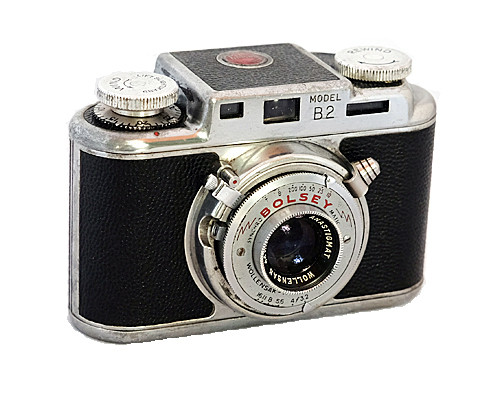
Back in the 1950's, my father owned a Bolex 16mm movie camera, a highly respected movie camera still sought after today. I purchased this Bolsey B2 35mm camera on EBay, and in researching it, learned it was designed by Jacques Bolsey, who designed the Bolex and other movie cameras. Bolsey was originally from Kiev, but moved to Switzerland, where he developed the Bolex line of movie cameras, and also the Swiss made Alpa Reflex camera.
Moving to the United States, Bolsey established the Bolsey Corporation of America, and produced the Bolsey B 35mm camera, followed by the B2, the model shown here. The Bolsey B2 is a finely made camera with a quality feel to it. It is very small, only 4-1/8 inches wide, 2-3/4 inches high, and about 2-1/2 inches deep at its widest point. Although not apparent in the photo,it has a somewhat triangular shape, like the Exacta cameras.
The Wollensak shutter has speeds of 1/10, 1/25, 1/50, 1/100 and 1/200 seconds, plus T and B. Like the Kodak 35 cameras described above, the shutter is cocked as the film is wound, and has double exposure protection. The Wollensak 44mm f/3.2 lens has f/stops of f/3.2, f/4, f/5.6, f/8, f/11, and f/16. The rangefinder window is fairly large and much easier to focus than the Kodak 35 RF camera or the Argus C3. The composing viewfinder is centered over the lens to minimize parallax error.
While the camera shares some design features with the Kodak 35 series and the Kodak Signet 35, its build quality is on par with the Kodak Retina cameras. The example appears to be fully functional and the cosmetic condition is very good.
Foldex cameras were made by Pho-Tak, which appears to be a name used by the United States Camera Corporation, based in Chicago, for some of its cameras. Most of its cameras were box cameras, but USCC also made a series of folders, such as the two shown below. Both cameras used 120 or 620 film to create 6x9mm images.
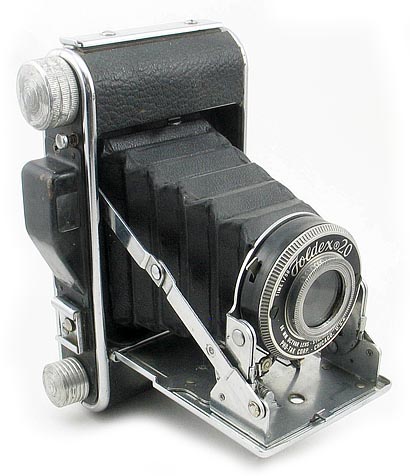
Foldex 20
The Foldex 20 was an American camera manufactured in the early 1950's by Pho-Tak. It was also available as a Sears Tower branded camera. The Foldex 20 actually had fairly good build quality, made of metal with a faux leather covering. The brightwork appears to be nickle-plated. It has the heft and feel of a quality camera. On the down side, it's basically a point and shoot, with fixed focus,fixed shutter speed, and fixed aperature.
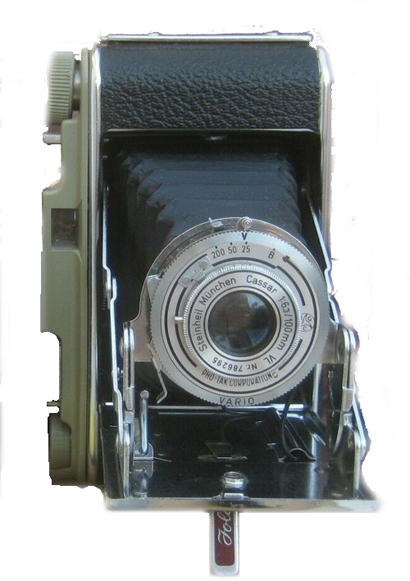 The 105mm Octvar lens has a fixed aperature of f/11. The shutter speed is 1/50s, with an option for time exposures. Using the sunny 16 rule, an ISO 25 to 50 film would probably give the best restults on sunny days. ISO 100 film could be used on an overcast day. This one belonged to an uncle.
The 105mm Octvar lens has a fixed aperature of f/11. The shutter speed is 1/50s, with an option for time exposures. Using the sunny 16 rule, an ISO 25 to 50 film would probably give the best restults on sunny days. ISO 100 film could be used on an overcast day. This one belonged to an uncle.
Foldex 30
Pho-Tak improved on the Foldex 20 with its successor, the Foldex 6.3, which collectors often refer to as the Foldex 30. The Foldex 30 sports a German made Steinheil-Munchen Cassar 100mm f/6.3 lens and a Vario shutter offering shutter speeds of B, 1/25, 1/50, and 1/200s. I found this one on EBay for $38.00, complete with a roll of film (exposed, in the camera), the original flash, instruction manual, and camera bag.
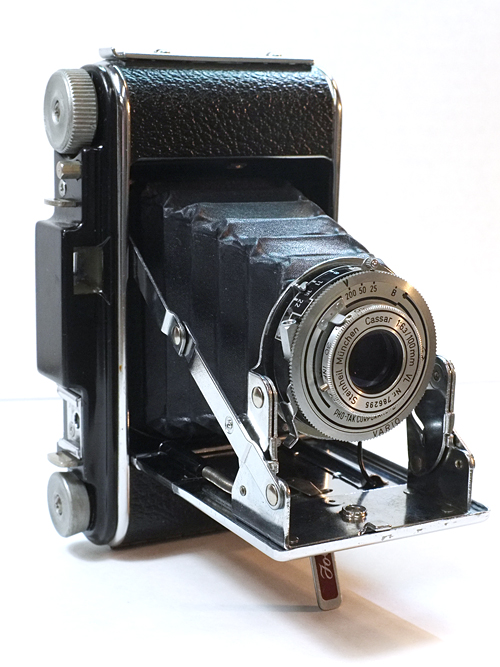 Although the fit and finish of the camera is very good, I though the gray plastic top plate (photo, right) distracted from the otherwise good looks of the camera. I removed the knobs and top plate, which is quite simple, and painted the top plate black and the knobs metallic silver.
Although the fit and finish of the camera is very good, I though the gray plastic top plate (photo, right) distracted from the otherwise good looks of the camera. I removed the knobs and top plate, which is quite simple, and painted the top plate black and the knobs metallic silver.
The assessory shoe is actually a dedicated hot shoe for the flash, and the flash contact prevents other accessories from mounting, so I unsoldered the contact as I have no plans to ever use flash with this camera. I also have to to use an extender as the shoe fits between the stap lug and viewfinder housing, blocking most accessories from sliding on to the shoe. Shown bottom right is the Foldex 30 with a rangefinder attached. The camera works very well and takes good images.


Univex AF-5 Minicam
No, AF doesn't stand for autofocus, although the fixed lens required no adjustment. Another camera that belonged to my mother, the 1938 Univex AF-5 was the last in a line of Univex cameras that were extremely popular, selling over a million during the Depression. Marketed as a less expensive alternative to the Kodak Vest Pocket camera, the Univex camera used proprietary UniveX 00 film. This camera still has its original box and owner's manual.
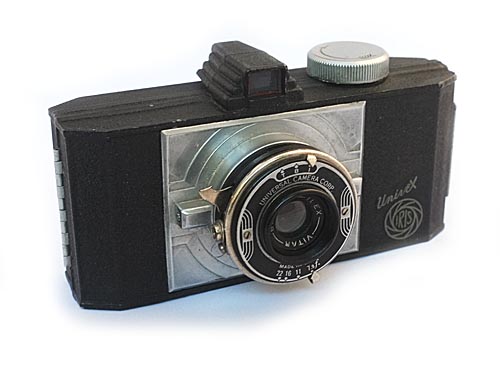
Produced from 1938 to 1942, the Univex Iris was the Universal Camera Corporation's effort to market a more upscale camera to compete with the Argus A series and imports. In nice Art Deco styling, the camera featured a collapsible 50mm lens, with f stops ranging from about f/8 to f/22. Although the lens was fixed focus, three shutter speeds were available: I, for instantaneous, B and T. For most shooting, the I setting would be used. Like the Univex Minicam above, the Iris used proprietary No. 00 Universal film. There was a space inside the camera for a spare roll of film. Other amenities include provision for a cable release and a tripod socket.
I found this example on EBay along with its original box at a very decent price. The camera is in excellent cosmetic condition, and appears to be in working order. The B and T settings work correctly, and the I setting works, probably at about 1/50th of a second. The lens diaphragm works properly as well. The lens looked pretty hazy, but it turned out to be dust inside the lens, which cleaned up from inside with a Q-tip and alcohol. As a bonus, the film take-up spool is present.
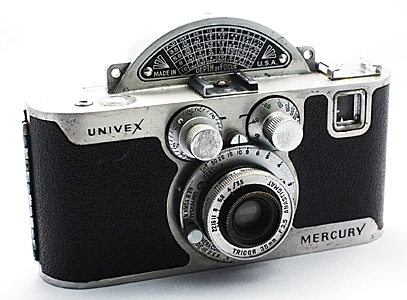
Introduced in 1938 to complete with Leica and Contax imports, the Univex Mercury sold for $25. It was a very well-built, although unique camera, featuring a rotary shutter, which accounts for the circular protrusion on the top plate. The camera boasted a top shutter speed of 1/1000th of a second. A later version increased the shutter speed to 1/1250 to match the Contax II. The Mercury was a half-frame camera using special 35mm film made in Belgium. The Univex Mercury was the first camera to have a hot shoe for the accessory flash. The lens is a Tricor 35mm f/3.5. This is a quite clean example I found on EBay, and appears to be functional. After WWII, production resumed as the Mercury II, using standard 35mm roll film.
Vintage Japanese Cameras
Vintage Former Soviet Union Cameras
Vintage Polaroid Cameras
Vintage Prime Lens Comparison
Vintage Photography Accessories
Gallery of Images from Vintage Cameras
Home